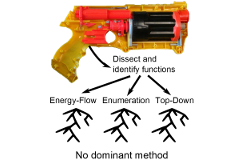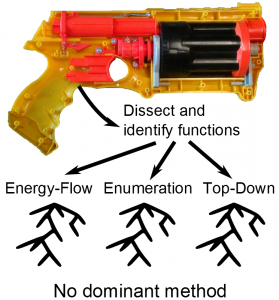The purpose of this study is to begin to explore which function identification methods work best for specific tasks. We use a three-level within-subject study (n ¼ 78) to compare three strategies for identifying functions: energy-flow, top-down, and enumeration. These are tested in a product dissection task with student engineers who have minimal prior experience. Participants were asked to dissect a hair dryer, power drill, and toy dart gun and generate function trees to describe how these work. The function trees were evaluated with several metrics including the total number of functions generated, the number of syntactical errors, and the number of unique (relevant and nonredundant) functions. We found no statistical, practical, or qualitative difference between the trees produced by each method. This suggests that the cognitive load for this task for novices is high enough to obscure any real differences between methods. We also found some generalized findings through surveys that the most difficult aspects of using functional decomposition include identifying functions, choosing function verbs, and drawing the diagram. Together, this may also mean that for novice engineers, the method does not matter as much as core concepts such as identifying functions and structuring function diagrams. This also indicates that any function identification method may be used as a baseline for comparison between novices in future studies.
Comparing Functional Analysis Methods for Product Dissection Tasks
Authors: Joran W. Booth, Tahira N. Reid, Claudia Eckert, Karthik Ramani
Journal of Mechanical Design J. Mech. Des 137(8), 081101 (Aug 01, 2015) (10 pages)
doi: 10.1115/1.4030232
https://doi.org/10.1115/1.4030232

Joran
Joran is a research scientist and lecturer at Yale University and a Co-Advisor with Professor Tahira Reid. He received the degree of D-PhD in the School of Mechanical Engineering at Purdue University. He received his bachelor's in mechanical engineering from the Brigham Young University. His research focuses on how students abstract and solve complex problems in early design phases, with a special emphasis on functional decomposition and sketching/visualization. Other research interests include prototyping, engineering history, education, family science, and history. Joran spends his free time volunteering, playing board games, hiking, playing music, or spending time outdoors. His past projects include starting the Purdue Maker's club, various sketching workshops, and simple robots. He recently finished an internship at IMMI, a top automotive safety products company. Joran is a member of ASME and the Order of the Engineer. You can find more information at http://joranbooth.wordpress.

